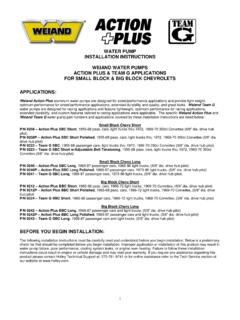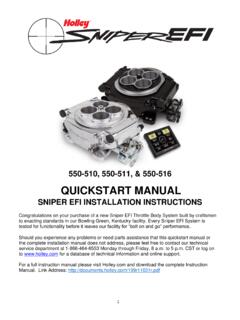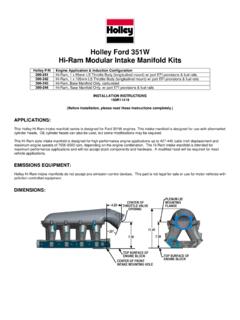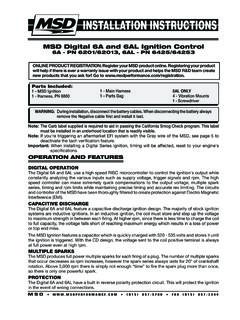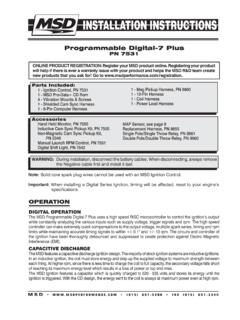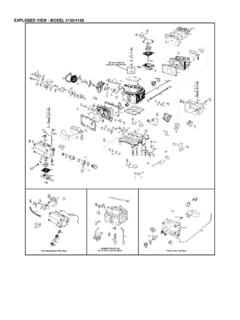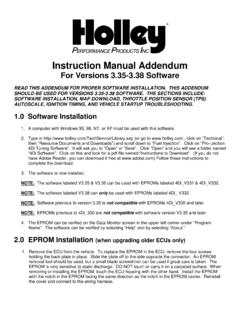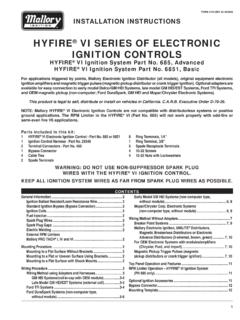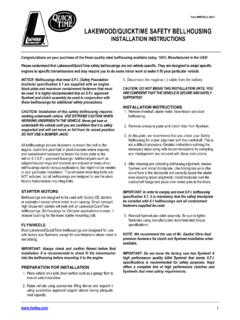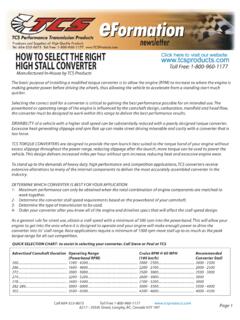Transcription of HOW TO SELECT THE RIGHT CARBURETOR SIZE - Holley
1 Volumetric EfficiencyBefore you can determine the correctcarburetor size for your engine, youmust know its volumetric efficiency is an indicator ofhow well an engine can breathe. Thebetter an engine s breathing ability the higher its volumetric efficiency. It isexpressed as the ratio of the actualmass (weight) of air taken into theengine compared to the mass whichthe engine displacement would theo-retically take in if there were no ratio is expressed as a percent-age. It is quite low at idle and lowspeeds and varies with engine efficiency should becomputed at the expected operatingRPM or your engine the following examples as aguide to estimate the volumetric effi-ciency of your engine.
2 (A) An ordinary low-performanceengine has a volumetric efficiencyof about 80% at maximum torque.(B) A high-performance engine hasa volumetric efficiency of about 85%at maximum torque.(C) An all-out racing engine has avolumetric efficiency of about 95%at maximum highly tuned intake and exhaust sys-tem with efficient cylinder head portingand a camshaft ground to take fulladvantage of the engine s other equip-ment can provide such complete cylin-der filling that a volumetric efficiency of100%, or slightly higher, is obtained atthe speed for which a system is graph below can be used to findyour airflow requirement.
3 It s based on100% volumetric efficiency so any indi-cated airflow must be multiplied by thevolumetric efficiency of your particularengine. Use a CARBURETOR with an air-flow rating equal to or slightly smallerthan the air requirement of s take for example, a 300 V-8 which has a maximum RPM limitof 8000 RPM. It s been determined thatthis particular engine has a volumetricefficiency of 85%. According to ourchart the engine s airflow requirementis 700 at 100% volumetric effi-ciency. At 85%, however, the is 595 This enginewould, therefore, require a 600 :Supercharged engines generallyrequire carburetors with 40% to 50%more than normally aspiratedengines.
4 Holley offers a new line ofsupercharger carburetors . These carbsare identified by this logo:HOW TO SELECT THE RIGHT CARBURETOR SIZEAIR FLOW Cubic Feet per MinuteRPMAIR FLOW vs. ENGINE RPMwith Various DisplacementsCHART BASED ON100% VOLUMETRICEFFICIENCY450 CID400 CID350 CID300 CID250 CID200 CID150 CID100 CID10006004002002000400060008000800 For high performance engines a car-buretor with mechanical secondarieshas an inherent advantage over a car-buretor with a controlled secondarysystem (air valve or vacuumdiaphragm).
5 This is possible becausea controlled secondary CARBURETOR , untilit reaches wide open throttle, will nothave as great a pressure drop belowthe throttle plates as would a mechani-cal secondary unit. The greater thepressure drop below the throttle platesthe more dense will be the fuel/aircharge to the engine and, hence, themore care, however, must be takenin selecting the correct size mechanicalsecondary CARBURETOR for an applica-tion. Double pump, mechanical sec-ondary carburetors initially dependonly on the accelerator pumps to pro-vide adequate fuel until enough airflow can be established to begin pulling in themain system.
6 The larger the carbure-tor the higher the air flow required toaccomplish this. If the CARBURETOR istoo large, the pump shot will be con-sumed before the main system result is a bog or a sag .The handy chart, at RIGHT , will help youto determine the correct CARBURETOR sizefor your Size Selector*For Model 4150 Double-Pumpers,Model 4165 Spread-Bore, Model4500 DominatorMore about using the chart If yourcar has an automatic-transmission,make sure you know the converter stallspeed before using the chart. If indoubt, use the figure shown for a typi-cal Chevrolet converter (1350 RPM).
7 Ifyou are using a modified converter fora racing application, make sure thestall speed is what you think it your car has a manual transmission,use the lowest RPM at which you usewide-open throttle. This must be a veryconservative RPM (on the low-RPM side,that is!) and should be found by observ-ing your own driving habits in the vehi-cle involved. Watch your tachometer!The heavier the vehicle and the lower thenumerical axle ratio (higher gear ratio) the lower this RPM must engines from 300 to 400 CID, theright choice usually works out to be a650 to 700 CFM CARBURETOR .
8 A light car,such as a Camaro, Mustang or Dustermay be able to use a 700 or 750 CFMunit, especially with a high numericalgear ratio (low gear ratio). When indoubt, SELECT a smaller CARBURETOR sizebecause it will typically give betteracceleration times even though powermay fall off slightly at top RPM. Youcan believe that you'll be happier withthe smaller CARBURETOR nearly everytime!* From Holley carburetors &Manifolds by Mike Urich and BillFisherSELECTING A MECHANICAL SECONDARY CARBURETOR40003500 MINIMUM RPM AT WIDE-OPEN THROTTLEENGINE DISPLACEMENT CIDCARBURETOR SIZE CFMGrey line is EXAMPLE described belowBC300050040030020060065070075080085 010502500200015001000500 INSTRUCTIONS1.
9 SELECT minimum RPM at wide-open throttle in col-umn A; this will be converter stall speed on carswith automatic transmissions. Do not over-esti-mate RPM column SELECT engine size (cubic inches) in column Draw line between selected points in columns A &B, extending the line to intersect column recommended CARBURETOR size is readfrom point at which line crosses column :350 CID engine with 1350 RPM converter stall speed. (Typical for stock Chevrolet converters).NOTE: Applies only to mechanically vs.
10 Engine RPMFor Model 4150 Double-Pumpers, Model 4165 Spread-Bore, Model 4500 Dominator25
